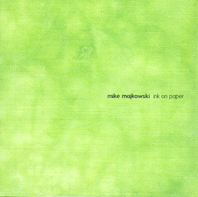http://www.creativesourcesrec.com/
 |
Mike Majkowski, Ink on Paper |
Opening the CD package, I notice that the disk and inside cover are decorated with drawings of ants running about, and I immediately think of manuscript notes that have left the stave and run off, perversely out of control—a portent of what I am about to hear?
On first listening, however, Mike Majkowski’s choice of notes seems deliberate and carefully calculated. This is a solo CD for double bass in which Majkowski builds on the musical languages that have emerged during his engagement with Splinter Orchestra and related musicians—Jim Denley, Chris Abrahams and others—using his highly evolved playing techniques to produce some dazzling pieces. There seems to be growing interest amongst contemporary musicians in the use of the double bass as a solo instrument, possibly because of its great range, tone and timbre and the amazing effects that can be produced. This CD, Ink on Paper, recorded in Sydney in 2008, does not appear intended as an exemplar of bass literature, but is rather focussed in a particular area, and for the most part, the bass is not made to sound like a bass at all, but like other, sometimes novel, instruments.
The title of the first track, “Pizzicato,” correctly describes the method of playing but does not convey the extraordinary way in which Majkowski plays, nor the complexity of the composition. The work begins with a series of rapid, cascading notes, punctuated by stabbing glissandi, all in the higher registers of the instrument, with occasional bowed gestures in the lower registers. As it develops, we hear background breathing and wordless vocalising, with light tapping on the bass’s body and on the strings. There is no central melodic line, but rather a series of note clusters. It sounds so dextrous, you wonder how it could be performed by one person. The deepest sonorities of the double bass are rarely evident in this track, though when they appear they contrast and thus emphasise the high, chattering notes that evoke ant conversations.
The short second track, “Foam and Straw”, combines high-pitched bowing with an intense vibrato that produces a series of atonal, warbly squeals and screams, which then segues into extremely fast bowing in the lower registers. It sounds like the bow is skittering across the strings, and one can imagine Majkowski’s bowing arm looking like a soft blur as it moves. “First Words, Dribble" is the intriguing title of the third track, demonstrating further extreme bowing with, at one point, double stopping and, later, whistling and vocalisation, the whistling and wordless voice harmonising with the bowed sounds, showing how the bass and the human mouth can mimic each other.
Most startling is the title track, "Ink on Paper," a series of short, sharp gestures that sound like they come from a synthesiser capable of playing microtones. Multi-tracking is used to build up these squeaky notes into an increasingly chaotic and dense weave, as if we are listening to a gigantic colony of sea birds all squawking their heads off.
The final track, “Current,” begins with strumming across all the strings, with long intervals to emphasise the harmonics and resonances that follow each gesture. These pauses make for a meditative work, and again, the emphasis is on the nature of the sound that can be produced and its musical possibility.
Majkowski’s CD is an extended study of how the double bass can be played and, particularly, how it can be made to generate an entirely new range of sounds. Each of the five tracks is a study based on different playing techniques. Evidently the work is improvised, but Majkowsi is clearly familiar with these techniques, and the combinations and permutations of the musical figures he generates presumably draw on extensive explorations of the instrument. There is presumably some detailed planning behind the track “Ink on Paper,” the result emerging from the overdubbing and mixing as much as the playing, producing a highly calculated work.
This CD reveals new languages of sound as well as of form and technique. This is cerebral, exploratory music. It's about breaking sound down into its most fundamental constituents and then rethinking it, taking elemental material, such as a bowed or plucked note, a strummed chord, a glissando or even a resonant interval, and building up a collage from these fragments. The balance between improvised and composed elements, between the spontaneous and the planned, is not the only interest; rather it is the sonic material and how it is worked that establishes the aesthetic. The music does not overwhelm or obscure the sonic ingredients, but sits in parallel with them—a possible metaphor might be appreciating pixels and picture simultaneously. The result, in the intelligent hands of a composer-performer such as Majkowski, is an entirely new and involving musical experience, a reinvention of music.
Chris Reid
© Chris Reid; for permission to reproduce apply to [email protected]








 back
back